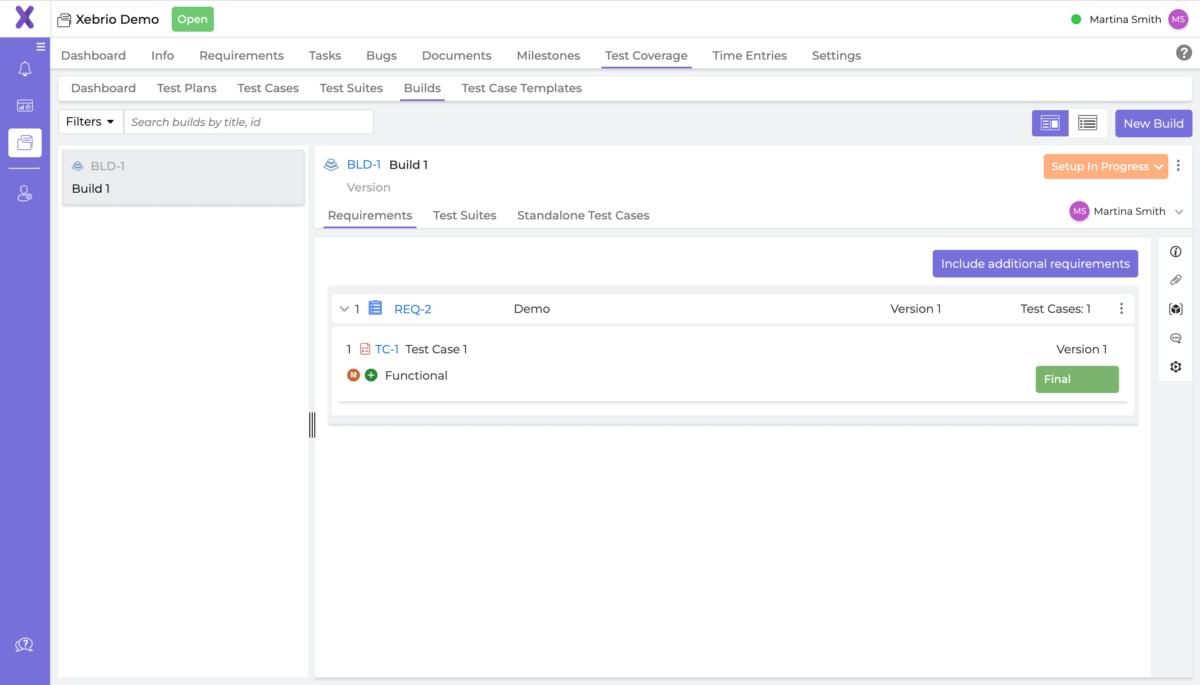Xebrio Software Review
Read our review guidelines.
Xebrio brings together requirements management and end-to-end traceability with task management and test coverage all the way to release management. It’s a project management ecosystem that is perfect for technology-led teams, with workflows and an easy interface with a low learning curve.
If you are currently juggling requirements and test cases on spreadsheets, then Xebrio could be the perfect choice for your team. Read on!
Summary
Product: Xebrio
Company: Xebcore Inc .
Cost and plans: Free 14-day trial. For a limited period, they are offering a flat-rate for start-ups and small teams of $10 for up to 10 users. From the 11th user, billing depends on plan chosen: task management, requirements management or requirements and test coverage, starting from $10 per user per month.
Hosting model: Cloud only
Languages: The interface is available in English only but other languages are on the roadmap.
Website: Xebrio.com
What is Xebrio?
Xebrio is a project management ecosystem that spans across various industry verticals such as maretking, HR, and IT.
Requirements management is where it starts. From there, it’s a seamless journey into task management, project management, testing, bug tracking and documentation.
Designed for different project teams , it’s a single place that manages the work from idea through to deployment.
There are three main workflows that you can take through the solution. They all start with creating a project. From there, you can customize your journey, but the most common workflows as I see them would be:
- Task management workflow: Used for creating tasks and bugs.
- Requirements management workflow: Create and track requirements through various iterations until they are reviewed and finalized.
- Requirements and test coverage workflow: Link test cases to requirements, create the build and test sessions, and define the release.

Managing requirements in Xebrio
I find requirements management pretty difficult on most projects. It’s not because the requirements themselves are difficult, but the iterations and sign off create so many documents that even with version control it’s tricky to stay on top of it.
So, the idea of software that eliminates the need for tracking spreadsheets is good for me. There are so many disadvantages to using spreadsheets for requirements management!
Within Xebrio you can document your requirements. Give each requirement an owner and allocate reviewers and contributors. Then set other parameters to help you manage them such as:
- Priority
- Estimate
- Description (this is where most of the info goes)
- Attachments
- Comments
- Tags.
Then use the workflow to send it for stakeholder review either inside or outside the organization. Any changes push the requirement back to draft mode and reviewers have to take another look. Once changes are wrapped up and included, mark the requirement as final and you’re done.
Of course, you can change a requirement later, if necessary, because we all know that happens often. Users can create new versions of the same requirement because the requirements versioning feature makes that possible.
Xebrio includes built-in industry standard templates to use for requirement elicitation, which will help speed up getting your project started.
I also liked the fact you can log time and link tasks to a requirement so you can track your effort from the very early days of the project. Later, you can come back and link test cases and even bugs to your requirements so you’ve got that full lifecycle.
Task management
Xebrio also does the more ‘traditional’ task management, but fully linked in with all the other features.
You can do all the stuff you’d expect like
- Create and manage tasks and subtasks
- Add task descriptions
- Add estimates
- Link tasks to requirements and milestones
- Assign people to tasks (and assign ‘watchers’ – helpful if you want to be aware of progress but aren’t actually responsible for the work)
- Organize tasks by task type, status or dates.
Xebrio doesn’t have a full Gantt chart view for the work, but it does allow you to manage by milestone. Each project can be broken into milestones and tasks can link to milestones. Later on, you can combine tasks, bugs and test sessions under the milestone.
This is how I would track deliverables: set them up as milestones and then align the rest of the work under that.
Testing
I’ve not seen a project management tool that so neatly integrates the world of testing. And having lived through a few nightmare projects, I know important it to take a professional view of software testing. In fact, the project where we had professional testers was the one that went the most smoothly in terms of technical rollout. Yes, we found bugs, but at least we found them in the test lab and not in live.
Xebrio allows you to manage testing across the project. You can:
- Create and manage test cases
- Set up test plans
- Map requirements to test cases
- View statistics from test coverage.
After testing, you can do release management. Specify what goes into the build and what test cases feed into that build.

User experience
One of the criteria I use for assessing project management software is the user experience. I confess to not being a long-term user of Xebrio, but I like what I see. It’s not a super-basic UI but it is clean. It feels modern and there are multiple tabs, folders and a tree structure that allows you to dig into where you need to be.
Xebrio also has all the collaboration features you’d expect in modern work management software. For example, you can chat, attach documents, work on the same requirement at the same time and set up work groups for collaboration.
Users have defined permissions so you don’t have to give everyone access to everything. Documents can be made private, if necessary, which is a feature I would use if I had external consultants or suppliers on my team.
There is a comprehensive online help library but it is quite text-based. I would benefit from having more screenshots in there. I found the tool intuitive so I would only expect to have to use the help for things I was struggling with or features I was using for the first time.
Reports
You can get reports out, and the dashboard is clean. I think there is scope in the future for the tool to add in more reports and more flexibility with the existing reports. But for now, and for most needs, the reporting is good enough.
Apps and integrations
There is a Jira integration for issue management. Jira doesn’t have requirements by default, but we all know that technical teams love it and you might find it hard to get them to switch to another product. With Xebrio you can manage your requirements and project tasks while you continue to use Jira for other use cases.
There is integration with Asana planned, which I can see will be very useful for the non-technical teams that have chosen to use that project management tool but still need to control releases and requirements: Marketing, I’m looking at you.
There is no app at the time of writing but after speaking to the Xebrio team on a Zoom call I know these are in the pipeline.
Advantages of Xebrio
Here are the main advantages of Xebrio as I see them:
- Requirement traceability: this is huge. You can track every single requirement across the project lifecycle.
- Xebrio has an offer for start-ups and small teams within a big organization for a limited period. It’s just $10 per month for 10 users for any of the plans. Check out the Xebrio pricing.
- Workflows: it’s a massive advantage to be able to set up automated review and approval cycles.
- Version tracking: save time by making sure everyone always has the latest information.
- Dashboards: the dashboard view is nice!
I can see how people come for the requirements features and stay for the ease of the workflow and test management.

Disadvantages of Xebrio
Here are the limitations of Xebrio:
- Staffing data only covers resource forecasting. There is time tracking but it seems a bit limited to me.
- There are no Gantt charts so if you want to do detailed planning or integrate into the rest of your project management world at work, you’ll have to use another tool for scheduling using Gantt charts.
- The product has extensive features for software use cases. This isn’t really a disadvantage, but it’s worth being aware of. If you don’t have technical testing or the need to track requirements, this tool is over-powered for you.
Ready to try Xebrio? There’s a free 14-day trial (no credit card required).
Xebrio Software Review

Do you find managing requirements a headache because you can’t trace them through a project to release? Check out what Xebrio does in our independent review.
Price: From $10 for up to 10 users
Price Currency: USD
Operating System: Cloud
Application Category: Project management
4
